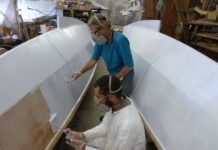How Many Zincs?
Could you please advise me on the subject of zincs, in particular about the number of zincs recommended for a boat? Several friends have advised me, Too many sacrificial zincs are detrimental to a boat. I believe the detrimental effect would be to a boat owners pocketbook or cruising kitty as he would be protecting all the boats around him as well as his own. But I don’t see anything really bad about using, lets say, 10 zincs rather than three. Would you please comment on the subject of how many and whether one can have too many?
Murray Catton
Chilliwack, British Columbia
Canada
Its a moderately difficult subject. Galvanic corrosion occurs when an electric cell is created by two different metals, either touching or connected by water or dampness. Tiny cells even can be created by different kinds of metals (or impurities) on the surface of what seems like one kind of metal. Electrical current flows from one metal to the other. If the flow encounters resistance, one metal suffers.
A sometimes overlooked means of preventing such corrosion is to minimize the use of dissimilar metals. However, its very difficult to avoid entirely. Another way is to insulate one metal from the other, with a gasket or film. Sometimes the insulation fails.
There are several other ways to deal with the problem.
Cathodic protection (the metal you want to protect becomes the cathode) can be provided by an impressed current, during which carefully regulated electricity is used to absolutely preclude corrosion. Not practical for small boats, too expensive for big ships (it is used for their ballast tanks), it is seen sometimes on luxury yachts and as an optional kit for some inboard/outboard installations.
A more practical way to deal with the problem is to save the cathode by offering up a less noble chunk of metal (an anode), knowing full well that it will be eaten away by corrosion.
Dealing now with Reader Cattons questions, the anodes used need only be sufficient to assure the protection of the cathodic metal. In other words, you should see some deterioration (by weight) of the anodes. Most sailors replace the anode on the prop shaft every year. The one coming off should be at least partially rotted away.
(Heat exchangers, engine blocks, gensets and condensers usually have their own zincs because the liquid electrolytes involved are different and independent.)
Are too many anodes detrimental?
Because the liquid in the vicinity of the cathode becomes alkaline, the alkali attacks wood backing blocks (often used with bronze through-hulls). It would be accelerated if excessive numbers of zincs were used. The alkali attack could be a severe problem with a wood boat. On steel boats, overprotection can cause oil-based paint to saponify. On aluminum boats, it can cause corrosion. But for most of us with fiberglass hulls, its not a worry. Still, why spend more money and, where necessary, drill more holes than you have to?
For thorough discussions of the complicated subjects of galvanic corrosion, along with the allied subject of bonding vs. not bonding, two books are recommended. Both contain formulas and methods of determining by weight how much anode is needed and exactly how it should be affixed.
The books are Nigel Calders Boatowners Mechanical and Electrical Manual, published by International Marine (800/822-8158) and Nigel Warrens Metal Corrosion in Boats, published by Sheridan House (914/693-2410).
For those who own metal boats, these books are bible-like. For all boat owners, the books are widely respected reference works.


































